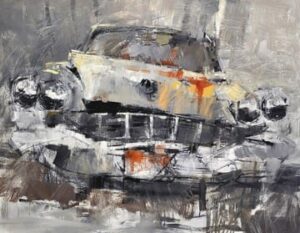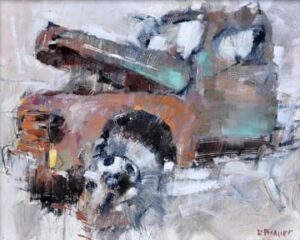When I first left the studio to pursue plein air several years ago I would look for a variety of subject. Real variety. In the course of events I might paint a winding road, a lone tree, a bicycle, two old men in a diner, a summer lake at sunset, a tractor in the barn, a cow, a fence row – anything that caught my fancy. I ended up with a lot of mediocre paintings that had nothing to do with each other. My world was already full of mediocre paintings and I certainly didn’t need to add to that pile. They lacked verisimilitude. Veracity. I didn’t know any of my subjects well enough to communicate my vision.

In my former life as a studio photographer I created reality from pretty much nothing every single day. I once had a client come to me saying he needed an image to illustrate a wholesome breakfast. To him this was an oversized muffin and a hot cup of joe. This was the 80s and that was pretty much a healthy diet in those days. So I gathered the props and baked up some blueberry muffins. A dozen muffins gave me one very nice example; not perfect but near so. Blueberries everywhere. I sliced it in half, placed it on a white saucer, then laid on a square of butter softened just enough to say piping hot. This was flanked by a fabric napkin (light blue), a diner type butter knife (generic, but proud), a cup of black coffee (very black with a small grouping of bubbles to say ’fresh, fresh, fresh!’) and a check from the waitress marked ‘Thanks, come again, Becky!”
I shot this on 8×10 transparency film, processed the image, and then delivered it to the client. He looked it over and said, ‘Boom! That’s it. Love it! And my favorite thing… the little pile of crumbs on the plate under the muffin. That screams verisimilitude”.
Yes, verisimilitude – the appearance of being true.
Well, the whole thing was dripping with verisimilitude. It had everything that read reality – the right props, the right angle of view, the right amount of selective focus, and the right lighting for a morning sunrise. It had story. He had it right to single out the crumbs because in the end it is the detail that made the illusion hold up. Without those crumbs, it would all have been sterile and certainly less convincing.

That experience has stayed with me and I think of it as I make paintings. To pull off a representational image one needs to have verisimilitude – a judicious and efficient use of details. If there is enough information to allow the viewer to relax and understand the point of view then the artist can play with how that image is presented, and do it with abandon.
Drawing is a big deal; Probably more important than anything else. Without a good foundational drawing representational imagery falls apart and doesn’t hold veracity. No one believes it. A poorly drawn building, or old tractor, etc. can quickly devolve into a cartoon version of itself.
Drawing is mark making that describes how objects fit in space. Line work – thick and thin – can tell the story on shadow and highlight. Edges, real or implied, depend on line. My preliminary drawing is generally loose but heavy on perspective issues. I can move things around easily to get the composition worked out. As the piece develops I come back and re-establish my lines and edges. You know, build the edges, knock ’em down, and rebuild. But that structure, that foundational structure, needs to be there throughout. If I have a painting that just doesn’t work it is almost always because the drawing has no interest or is just flat out wrong.

When I go out into the field I look for the unusual point of view. Everything has perspective whether figure, landscape, or still life and that needs to constantly be heeded in the building of the image. If that perspective is accurately built into the foundation one can hang paint all day long on the thing. Monumentality is all in point of view. Angles – find angles that pull the eye into the composition. And if possible, exaggerate those angles. Stretch the thing and make it dynamic. I look for ways to distort without a noticeable distortion.
I paint a lot of vintage cars these days. I can’t tell you a lick about engines; my brain doesn’t go that way, but I do dearly love the look of an old car, particularly those that have gone to seed. They are such wonderful still life subjects with almost universal appeal. It’s my ‘go-to’ thing to paint.
I recently had a solo show. I wanted a cohesive series of work that would tell a story as well as showcase my interests and vision. So it was cars. I had over 40 plein air paintings of cars. I edited this group down to a manageable number and then fleshed out the rest of the wall space with larger studio paintings done from photos, and field studies. What I came to realize in the course of things was that I was developing a comfort level with my subject that freed me to put more energy in the way I put marks on the page. And that is really my thing, anyway.

I’m a process guy. I came of age when DeKooning, Rauschenberg, and Jasper Johns were still making stuff. Those guys knew how to throw paint and create new ways of seeing art. Put it down, scrape it off, and do it again. Abstract Expressionism is a long way from the direct observation of plein air but the mark making should not be dismissed. If the drawing is sound then the mark making process can run through the clover and give us new ways to see the world in front of us.
The point of all of this is to know your subject. Know it inside and out in the same way you might know a piece of music. Own it with confidence. Your viewer will appreciate it. They won’t know why. They’ll start with a comfort level that keeps them engaged with the image. They’ll get it – and then they’ll want to dive in for the good stuff.
by Lon Brauer
by Lon Brauer
by Lon Brauer



Leave a Reply